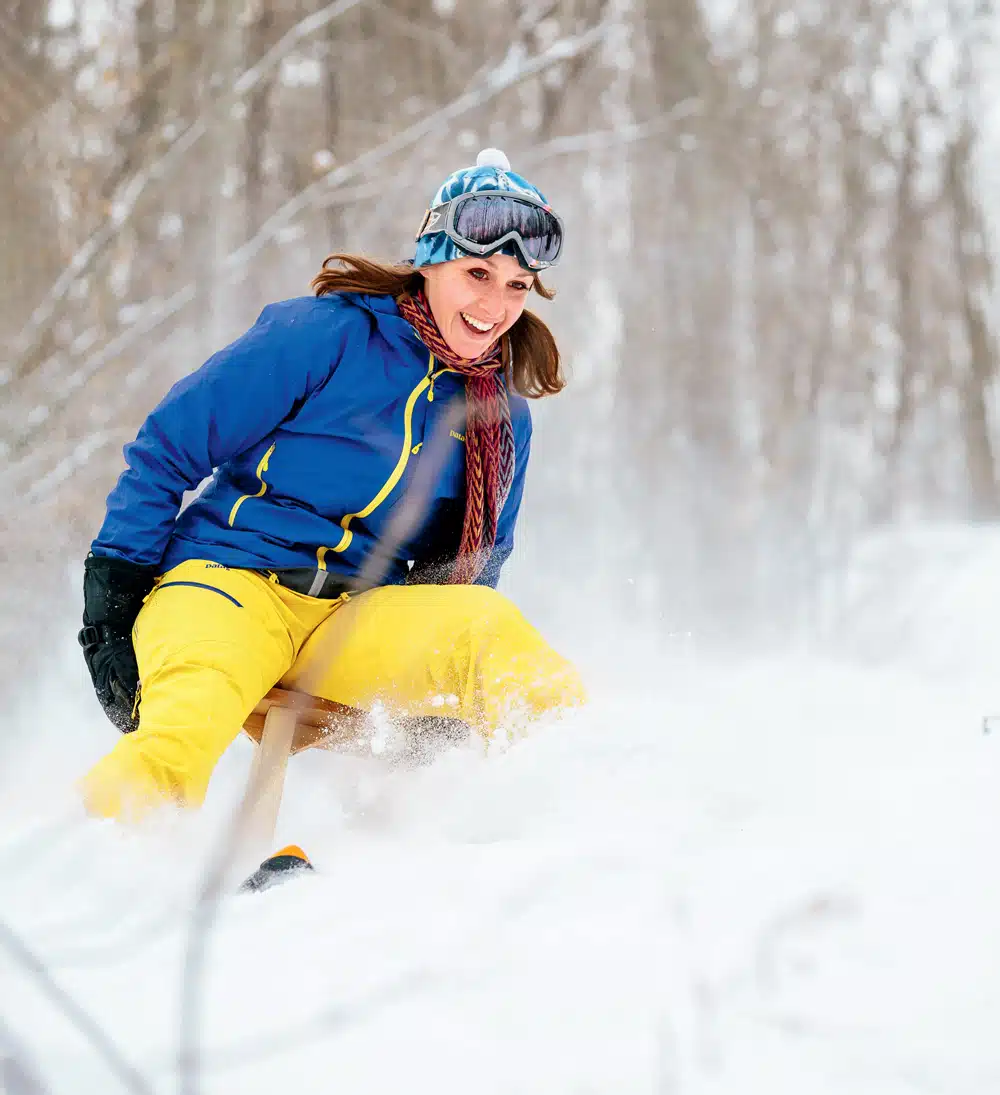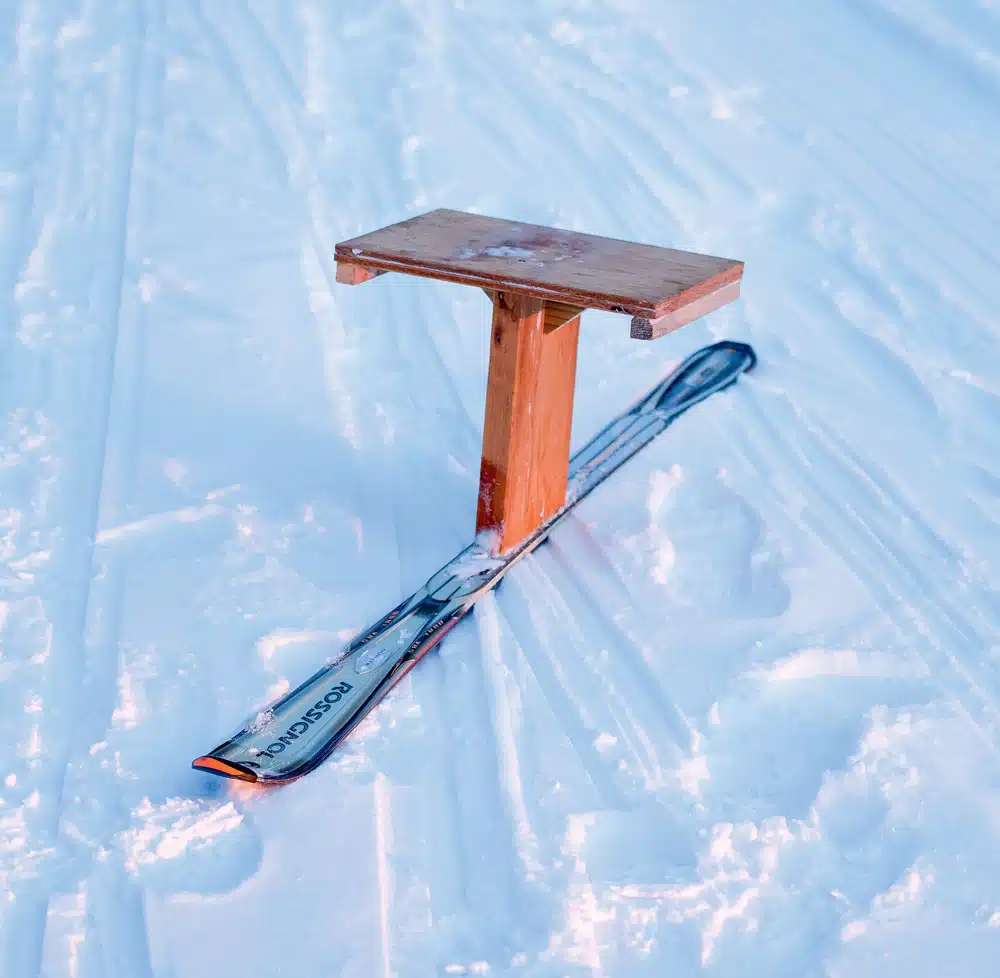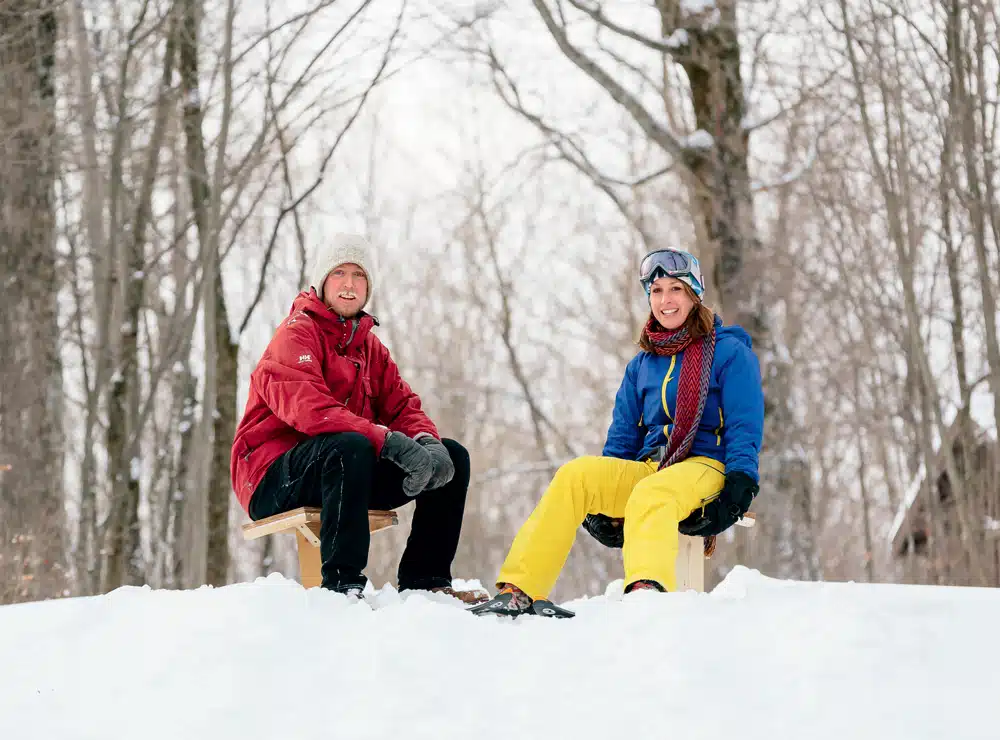The Joys of Jack Jumping | First Light
A timeless Vermont tradition that returns anyone to childhood.

Coffee By Design | Portland, Maine
Photo Credit : Katherine Keenan
Photo Credit : Oliver Parini
I find myself in the garage a few days before Christmas, searching cluttered corners for bits of scrap lumber and dusty Rossignols. My sister, Molly, an avid skier who typically logs at least two dozen Saturdays at Stowe each winter, gave birth to her first child last summer, and I’m thinking that a jack jumper—that’s right, a jack jumper—will be the perfect present for a time-crunched, cash-strapped mom. Where skiing is logistically intensive, jack jumping is quick and easy. Where skiing is pricey, jack jumping is free. Furthermore, a jack jumper for Molly is a jack jumper for Daisy, a gift from uncle to niece. As the saying goes: Get ’em while they’re young.
Jack jumping is without a doubt my favorite sport, and that’s because it’s more than a sport, more than exercise and technique and thrill; the satisfactions are athletic, sure, but historical too. In the pre-chairlift, pre-snowboard 1800s—an era of rolled rather than plowed roads, horse-drawn sleighs, and what must have felt like interminable gray months—Vermont farmers cobbled together snow-sliding devices for their kids that used a barrel stave as a runner, and a wooden bench on a short post as a seat. Legend has it that loggers also used rudimentary jack jumpers to move efficiently through the woods while sawing. And though I have no evidence on this front, there’s certainly a family resemblance between jack jumping and the European sport called skibock. As with many great folkways, the origins of jack jumping are uncertain, and it is this uncertainty—this power of a history bigger and deeper than any individual person or place—that I consider so enlivening.
Nowadays, in barns and basement workshops across the state, enthusiasts like myself take the basic elements—a single ski, a platform upon which to rest the fanny—and construct funky, one-of-a-kind models. I’ve seen the gamut, from a toddler’s toy (the Junior) to a sculptor’s art project (the Smithsonian) to a welded steel frame with shock-absorbing springs (the Cadillac) to a beery slap-together job (the Jalopy). Despite the variability in design, every jack jumper gives a respectful nod to the same shared heritage, the same New England of old. Or, putting it poetically, every jack jumper is a curve in the powdery run that this hobby has made, and continues to make, through seasons, terrain, home.
But honestly, I’m not musing on this highfalutin heritage as I search the cobwebbed hinterlands of the garage. Finally I locate the outdated, badly dinged, perfect-for-a-jack-jumper Rossignol that I stashed for safekeeping way back when. Unlike the slick, fancy, factory-produced gadgets we commonly rely on for fun in the 21st century, what I’m about to create will be candid, humble, pure.
A few cuts, a few screws….

I grin. In an hour I’ll be carving the packed driveway, test-driving my sister’s surprise.
—
A week later, on a zero-degree afternoon of thin clouds and glittery light, we drop Daisy at Grandma’s and head to Mount Philo in Charlotte. Twisting to the 968-foot summit, this state park’s snow-paved road was originally established in 1903 as a carriage track, and it has long been recognized as the meeting ground for Champlain Valley jack jumpers. For our purposes, a meadow flanking the parking lot will serve as today’s bunny slope.
“Think of it like a bike,” I say as Molly takes a seat, gripping the underside of her jack jumper’s bench with her hands and extending her legs straight out in the manner of a hamstring stretch. “You’re going to need some speed before things stabilize, you know?”
Her initial attempt is understandably timid, which means wobbly, which means one, two, three, four, five seconds and she’s flopped over onto her side.
Asks the smiling heap of yellow and blue Gore-Tex, “What should I do?”
“Nothing,” I reply. “It’s intuitive. Believe me, you’ll be ripping on your next try.”
My sister, so confident on alpine skis that she hucks herself off cliffs, has no idea how beginner-friendly jack jumping really is, no conception of the ribbony smoothness, the free-form delight, that’s about to rock her world. Sure enough, within 10 minutes the jack jumper appears glued to Molly’s snowpants, and within 30 minutes she’s arcing graceful turns, hooting and hollering.
We hike to the summit, rigs slung over our shoulders, and gaze at the main chain of the Green Mountains in the distance—peaks we’ve been skiing since childhood and that mostly forbid the use of jack jumpers (Jay Peak and Bolton Valley are the lone exceptions).
“I can’t believe I’ve lived in Vermont all my life and am only now getting into this,” Molly says.

Photo Credit : Oliver Parini
The sun sinks orange in the west. A woodpecker drums in the forest below. I imagine the hardworking farmer who stole away from his chores to assemble a pair of jack jumpers—one for his young son, one for himself. I imagine him and his boy standing on this exact spot in 1903 or 1913 or 1923, enjoying the stillness that anticipates the rush.
“Maybe we can get Grandma to watch Daisy again tomorrow?”
—
There’s so much that contributes to jack jumping’s allure, far more than I could ever hope to articulate. Following a session at the workbench, fitting together bits of so-called trash to form an elegantly simple device, it’s the Yankee thrift and do-it-yourself ingenuity. Following a two-mile cruise on Lincoln Gap, an unplowed pass in the serene heart of the Greens, it’s the engagement with wilderness, with a landscape that brooks no nonsense (roaring snow guns, $100 tickets, etc.). Sometimes, in the company of goofy friends, I’m convinced that the best thing about jack jumping is the way it returns us to childhood, to innocence, to play. And, of course, there’s the adrenalized glee, which is beyond fantastic.
But the tradition, the pay-it-forward quality, the generational aspect—this is what strikes me as most notable on the day of Molly’s introduction. Driving to Grandma’s afterward, she can’t stop talking about how Daisy will learn quickly and go faster than the boys and love jack jumping from the get-go. Listening, I recall my own initiation into the cult. When I was 18, a friend’s father shared with me his jack jumper, along with a story about the mentor—a blacksmith with a shaggy beard—who had loaned him one a decade before. I learned to “jump” that day, and I also learned to revel in the awareness that this under-the-radar pastime persists in hollows and on hillsides all over Vermont—persists, it seems, as genes persist in a line of ancestry. I learned, in other words, that a historical awareness allows us to ride out of the past, into the future, and, simultaneously, back into the past.
At Grandma’s I bring Molly’s jack jumper inside, set it by the fire, and balance Daisy on the bench, holding her upright. Brown eyes instantly fill with tears. The frigid wood through thin pajamas is sudden, shocking, and she shrieks.
“Just give it time,” I say, swooping my niece up with one hand, dusting snow from her diaper-puffed backside with the other. “Just give it time.”
Already I’m planning next year’s Christmas present, shaping it in the dusty, cluttered garage of my mind.





This is the first I’ve heard of the New England Jack Jumper. Growing up in western Pennsylvania, we had a very similar tradition commonly called the Yankee Jumper. I have one of the only commercially made models I have ever seen, made by the Butler Stamping Company in Butler, PA. All others were home made. This device seemed to be regional phenomenon, as no one I ever asked outside of western PA had ever seen nor heard of one. So now I learn that the tradition was also a part of New England. I wonder what the connection between these traditions might be?